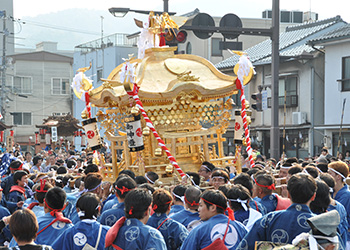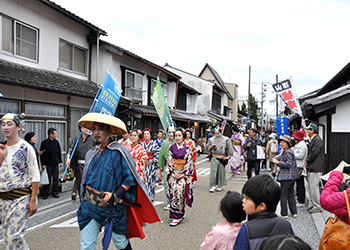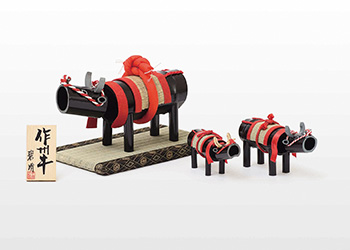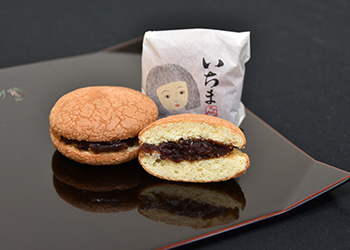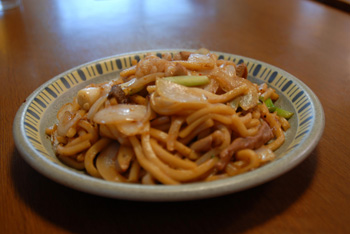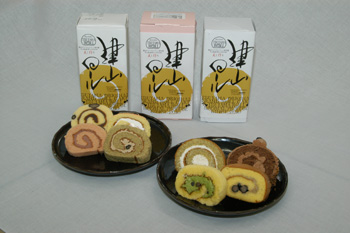Tsuyama
Tsuyama – A Castle Town of History and Culture
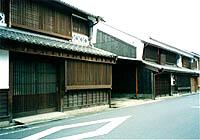 Since olden times, Tsuyama developed with its political center in Mimasaka, economic center in Izumo Kaido and transportation center along the Yoshii Canal. In 1603, a feudal lord, Tadamasa Mori, settled in this area, established his castle and developed a town around it. Today, the city roughly consists of two areas: Joto, on the eastern side of Tsuama Castle and Josai, on the western side. In the area where the old Izumo Kaido Highway used to run there were many accommodations which welcomed travelers visiting Izumo Taisha Shrine as well as massive samurai residences. The entire town is surrounded by trees with a canal running through and where a number of Buddhist temples and Shinto shrines are located. It is the city called “A Little Kyoto in Western Japan” which attracts visitors in every season.
Since olden times, Tsuyama developed with its political center in Mimasaka, economic center in Izumo Kaido and transportation center along the Yoshii Canal. In 1603, a feudal lord, Tadamasa Mori, settled in this area, established his castle and developed a town around it. Today, the city roughly consists of two areas: Joto, on the eastern side of Tsuama Castle and Josai, on the western side. In the area where the old Izumo Kaido Highway used to run there were many accommodations which welcomed travelers visiting Izumo Taisha Shrine as well as massive samurai residences. The entire town is surrounded by trees with a canal running through and where a number of Buddhist temples and Shinto shrines are located. It is the city called “A Little Kyoto in Western Japan” which attracts visitors in every season.
Sightseeing Highlights in Tsuyama
Tsuyama Castle (Kakuzan Park)
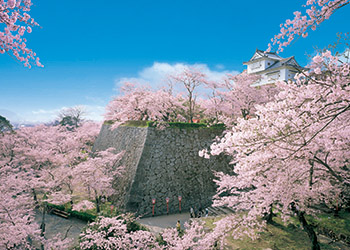 This is one of the most famous sakura cherry blossom viewing sites in western Japan. It was selected as one of the 100 Best Sakura Viewing Spots where a number of people come and enjoy cherry blossoms in spring. The castle is also selected as one of the 100 Best Castles in Japan.
This is one of the most famous sakura cherry blossom viewing sites in western Japan. It was selected as one of the 100 Best Sakura Viewing Spots where a number of people come and enjoy cherry blossoms in spring. The castle is also selected as one of the 100 Best Castles in Japan.
Shuraku-en Garden
 The second-generation castle master created this superb stroll-style garden with a large pond following the design of the Sento Imperial Palace in Kyoto. Every season is the best time to enjoy its beauty.
The second-generation castle master created this superb stroll-style garden with a large pond following the design of the Sento Imperial Palace in Kyoto. Every season is the best time to enjoy its beauty.
Tsuyama Nature Wonder Museum
 As many as 20,000 specimens are exhibited in this museum all about plants, animals and fossils, some of which cannot be seen anywhere else in the world. In the History and Folk Museum, the life of merchants during the Edo period has been recreated. This is a treasure house of Japanese wisdom and wonder.
As many as 20,000 specimens are exhibited in this museum all about plants, animals and fossils, some of which cannot be seen anywhere else in the world. In the History and Folk Museum, the life of merchants during the Edo period has been recreated. This is a treasure house of Japanese wisdom and wonder.
Townscape of Joto Area (Important Preservation District of Historic Buildings)
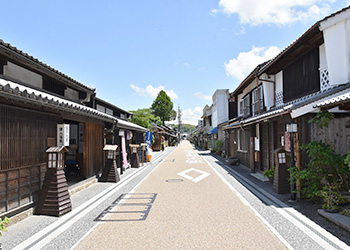 The old Izumo Kaido Highway in Tsuyama was an important road connecting Edo (present-day Tokyo) and Izumo (present-day Shimane). The area along the highway prospered and still retains the old scenery and atmosphere of each period of time ranging from the late Edo period (1603-1868) to the early Showa period (1926-1989). There is the birth house of Genpo Mitsukuri (a scholar of Western study) and Tsuyama Western Study Museum where historical materials related to Genzui Udagawa, a scholar from Tsuyama are exhibited.
The old Izumo Kaido Highway in Tsuyama was an important road connecting Edo (present-day Tokyo) and Izumo (present-day Shimane). The area along the highway prospered and still retains the old scenery and atmosphere of each period of time ranging from the late Edo period (1603-1868) to the early Showa period (1926-1989). There is the birth house of Genpo Mitsukuri (a scholar of Western study) and Tsuyama Western Study Museum where historical materials related to Genzui Udagawa, a scholar from Tsuyama are exhibited.
Sakura Shrine
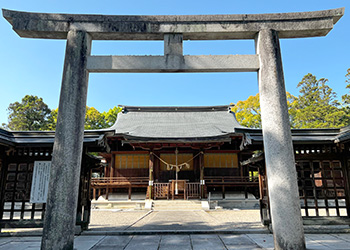 After the Genkō Rebellion, in order to comfort Emperor Go-Daigo who was exiled to Oki, Kojima Takanori carved a 10-character poem out of the trunk of a cherry tree, saying, "Do not let Heaven's blessing be in vain..." This anecdote is well-known from the Taiheiki. The setting for this anecdote is this shrine.
After the Genkō Rebellion, in order to comfort Emperor Go-Daigo who was exiled to Oki, Kojima Takanori carved a 10-character poem out of the trunk of a cherry tree, saying, "Do not let Heaven's blessing be in vain..." This anecdote is well-known from the Taiheiki. The setting for this anecdote is this shrine.
Important Annual Events in Tsuyama
Tsuyama Sakura Festival
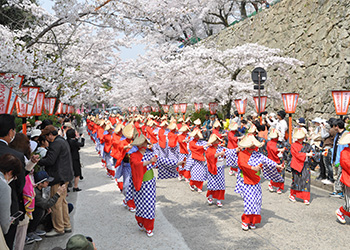 About 1,000 cherry trees reach their full bloom. The fallen petals on the stone walls tell of spring’s end. Night-time cherry blossom viewing is also recommended.
About 1,000 cherry trees reach their full bloom. The fallen petals on the stone walls tell of spring’s end. Night-time cherry blossom viewing is also recommended.
Tsuyama Summer Gongo Festival
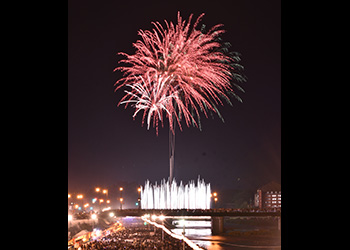 Along the Yoshii River Bank Park, fireworks, Gongo dance, and night festivals will be presented.
Along the Yoshii River Bank Park, fireworks, Gongo dance, and night festivals will be presented.
Traditional Crafts of Tsuyama
Hand-woven Sakushu Kasuri Textile
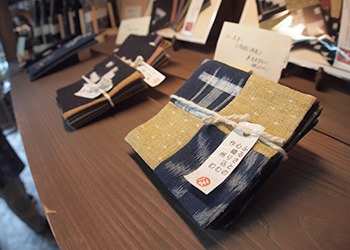 Kasuri is a traditional splashed pattern kimono made of cotton and is a traditional industry of Sakushu Tsuyama. Many households possessed a loom to weave Sakushu Tsumugi textile. After the yarns are dyed, they are woven in accordance with the design only with deep indigo and white colors. All handmade Sakushu Tsumugi is a traditional craft of Okayama Prefecture.
Kasuri is a traditional splashed pattern kimono made of cotton and is a traditional industry of Sakushu Tsuyama. Many households possessed a loom to weave Sakushu Tsumugi textile. After the yarns are dyed, they are woven in accordance with the design only with deep indigo and white colors. All handmade Sakushu Tsumugi is a traditional craft of Okayama Prefecture.
Yokono Washi Paper
 Generally, Yokono Washi is placed in between extremely thin and delicate gold or silver leaves in order to separate them one by one. The tradition of Yokono Washi was already flourishing around 1804-1818 and was highly recognized and cherished by the samurai governor who ruled over the region. The extreme thinness, durability and soft touch are all examples of highest quality work. It is designated as the traditional craft of Okayama Prefecture.
Generally, Yokono Washi is placed in between extremely thin and delicate gold or silver leaves in order to separate them one by one. The tradition of Yokono Washi was already flourishing around 1804-1818 and was highly recognized and cherished by the samurai governor who ruled over the region. The extreme thinness, durability and soft touch are all examples of highest quality work. It is designated as the traditional craft of Okayama Prefecture.
Food & Specialties of Tsuyama
Kirikasane
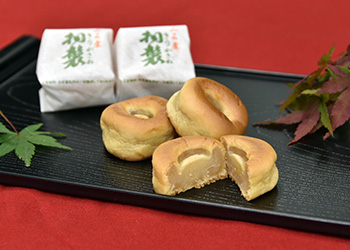 Popular sweets which uses fragrant yuzu (Japanese citrus) from the Mimasaka area of Tsuyama.
Popular sweets which uses fragrant yuzu (Japanese citrus) from the Mimasaka area of Tsuyama.
Jumangoku
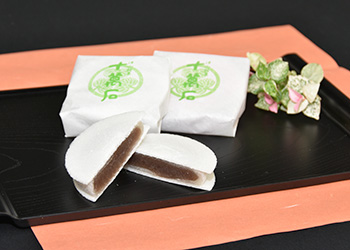 A sweet dumpling of a soft rice cake with a silky red bean jam interior, with the rice cake sandwiched by sticky Kyoto-fu (flour gluten cake).
A sweet dumpling of a soft rice cake with a silky red bean jam interior, with the rice cake sandwiched by sticky Kyoto-fu (flour gluten cake).
Hatsuyuki
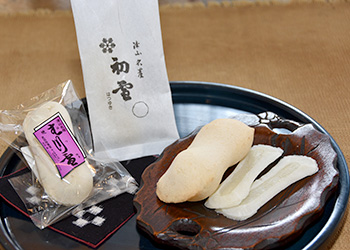 A traditional sweet of the Mimasaka area of Tsuyama. Sticky rice grown in Tsuyama and a small amount of sugar are the two major ingredients.
A traditional sweet of the Mimasaka area of Tsuyama. Sticky rice grown in Tsuyama and a small amount of sugar are the two major ingredients.
- Access
- Tsuyama Station on JR Tsuyama Line. A 70-min. bus ride from Okayama Airport
- Contact
- Tsuyama City Tourism Association
- TEL:0868-22-3310 / FAX:0868-22-3315
- URL: http://www.tsuyamakan.jp

